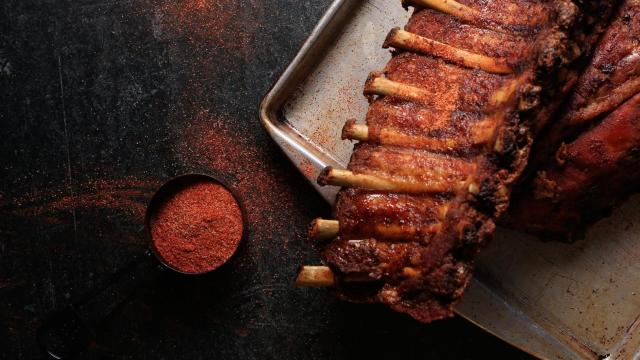I have never bought — never imagined I would buy — a seasoning blend that bragged about being “salt-free.” (“Couldn’t be me,” as the kids say.) I love salt — and have an ever-growing collection of sodium chloride to prove it. So I was slightly shocked and mildly scandalized when not one, but two BBQ guys suggested I use a salt-free rub on my long weekend pork shoulder. (Don’t worry, they were not suggesting I abandon the salt shaker entirely.)
How to salt your meat when grilling
Salting is actually a very important step in prepping your meat for the smoker or grill, but you should take care of it well before you apply your dry rub. How long before? At least a few hours if not days, depending on the size of your cut. (The amount of salt you use will also vary from cut to cut — Serious Eats has a pretty good guide for some of the most common.) Applying the salt this early gives it time to penetrate and season the inside of the meat, rather than simply sit on the surface. The salt draws water out of the muscles (that’s osmosis, baby), that water dissolves the salt (creating a very concentrated wet brine), and the meat absorbs the dissolved salt. By the time you’re ready to add a rub, your meat is thoroughly salted.
Unlike salt, a dry rub is meant to sit on the surface of the meat and create a crust of complementary flavours, and it should be applied right before your protein goes in your smoker or on your grill. Their ingredients vary wildly, but most rubs are comprised of a mixture of herbs, spices, chillis, and sugar. The flavour-containing chemical compounds in these ingredients are much larger than sodium chloride, and they cannot penetrate deep into the meat. (According to AmazingRibs.com, most rub ingredients only make it around an 1/8th of an inch below the surface.) That’s ok though, because dry rubs are supposed to sit on the surface and develop that nice bark, and they couldn’t do that if they disappeared into a pork butt.
How to make your own dry rub
There are a few saltless pre-made rubs out there (SnS makes a pretty decent one), but most commercial rubs contain far too much salt to be used on a piece of dry-brined meat (some are near 50% salt!). Luckily, making your own is very easy, and you can even add a little salt if you want — though you shouldn’t need to if you’ve properly seasoned your meat ahead of time. With the exception of the first recipe (which is really more of a cure), all of these simple rubs can be made without salt, and they take really well to a good riffing if you decide you want to chuck in whatever herbs and spices you have hanging out in your kitchen. Remember, you can always add a little salt to your dry rub if you think it needs it, but starting with salt-free rub puts you in control, and control is what ensures predictable (delicious) results every time.

Leave a Reply
You must be logged in to post a comment.